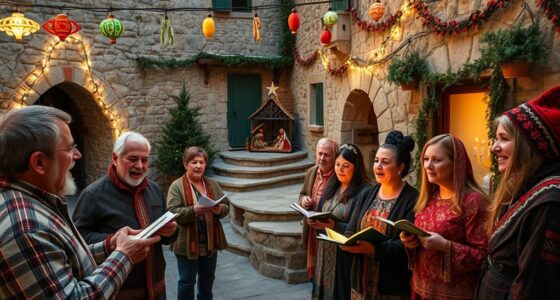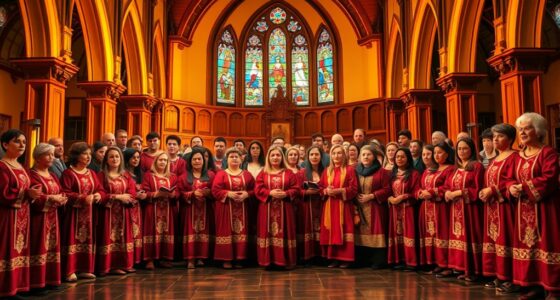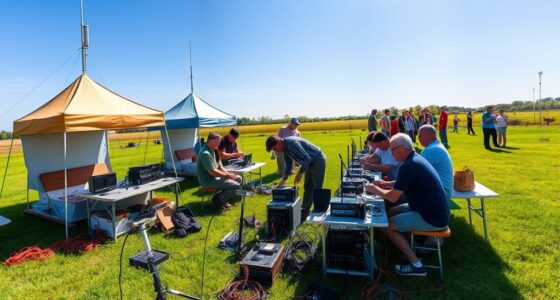Ancient festivals in Sardinia stem from a mix of pagan rituals, medieval traditions, and Christian influences that have evolved over centuries. These celebrations often connect to agricultural cycles, honor sacred sites, and feature symbols of fertility and prosperity. Practices like incubation rituals at Nuragic wells and festivals like Sa Sartiglia and Sant’Efisio preserve ancestral customs, blending spiritual meaning with community bonding. To uncover how these traditions continue to shape Sardinian culture today, keep exploring their rich history.
Key Takeaways
- Sardinian festivals originate from Middle Ages, blending pagan rituals, Christian traditions, and folklore with ancient fertility symbols.
- Many festivals trace back to Nuragic and prehistoric times, involving sacred sites, incubation, and water-related rituals.
- Medieval manuscripts document early festivals like Sa Sartiglia, highlighting their long-standing cultural and spiritual significance.
- Ritual practices often include offerings, sacred architecture, and communal stays near holy sites, reinforcing ancestral connections.
- Symbols such as fertility figures, masks, and natural elements reflect ancient mythologies and the island’s deep spiritual heritage.
The Roots of Sa Sartiglia and Its Pagan Origins
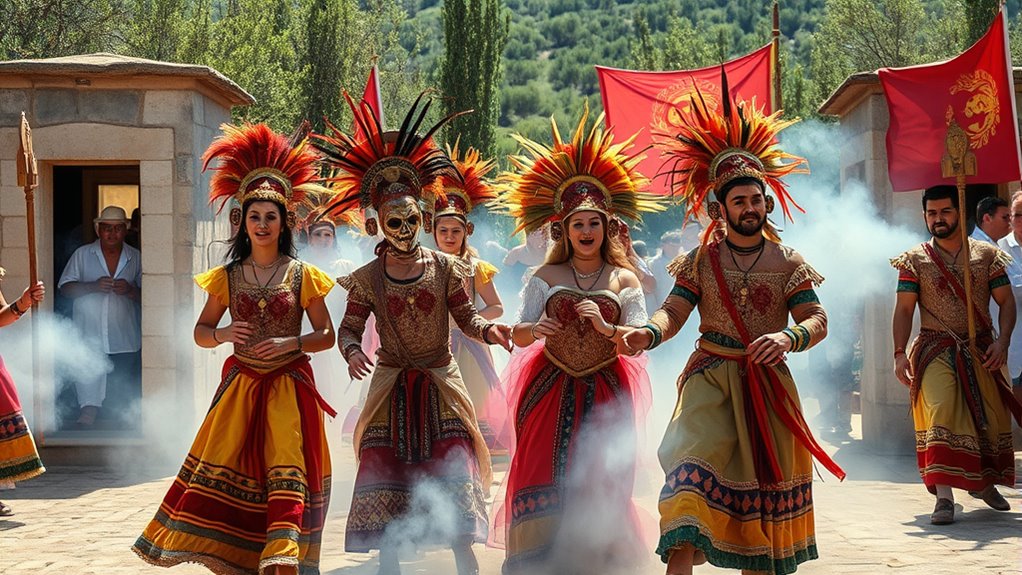
The roots of Sa Sartiglia trace back to the Middle Ages, reflecting a blend of pagan rituals, Christian traditions, and local folklore. You’ll find that its origins are linked to 12th-century military tournaments, possibly inspired by the crusades. Organized by historic guilds, such as the Farmers’ Guild and the Guild of Carpenters, the festival is first documented in Oristano in 1547. Throughout history, it evolved while keeping its cultural core intact. The festival’s rituals also reveal pagan influences, like masked riders and symbolic acts—such as piercing a star with a sword—that connect to nature and agricultural cycles. Medieval manuscripts mention Sa Sartiglia, emphasizing its long-standing significance. The festival’s roots reflect a rich tapestry of ancient traditions that have persisted through centuries, shaping its mystical and cultural identity. The celebration’s enduring popularity underscores its importance as a symbol of Sardinian resilience and cultural continuity. Additionally, the preservation of these ancient customs demonstrates the community’s dedication to maintaining their cultural heritage amidst modern influences.
The Historical Significance of the Festival of Sant’Efisio
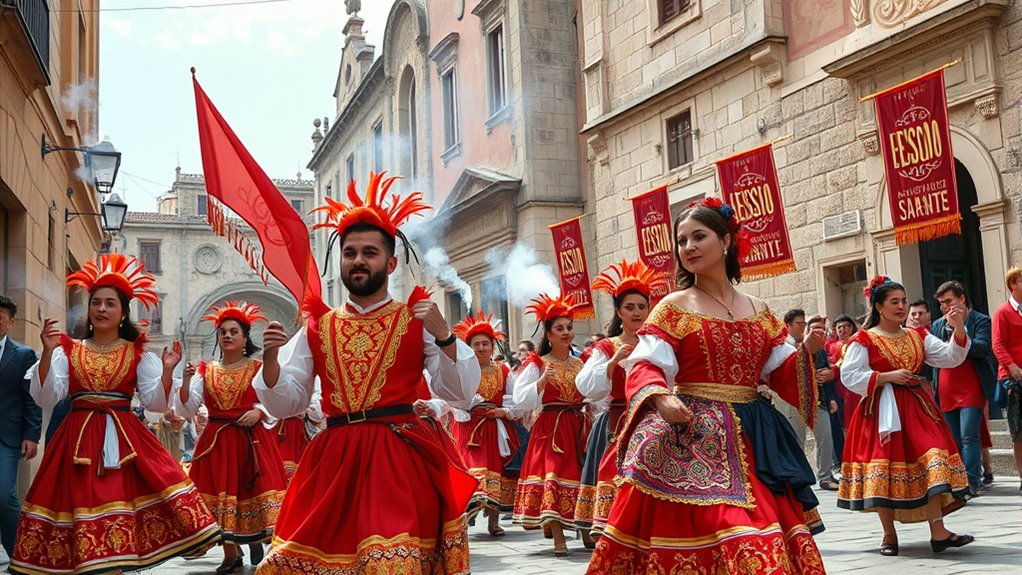
You can see how the Festival of Sant’Efisio reflects Sardinia’s history, starting from its origins during a devastating plague to its ongoing role in community life. This event has evolved over centuries, maintaining its religious and cultural roots while adapting to modern times. It’s a powerful symbol of Sardinia’s identity and resilience, connecting past hardships with present traditions. The festival’s deep historical roots and continuous celebration underscore its importance as a cultural heritage that has persisted for over three centuries since the 17th century, serving as a unifying event for the Sardinian people.
Origins and Evolution
Emerging in the mid-17th century, the Festival of Sant’Efisio was born out of Sardinia’s desperate need for divine protection during a devastating plague. When Cagliari lost nearly half its population, inhabitants vowed to honor Sant’Efisio if the disease subsided. Once the plague ended, the first procession took place around 1656 or 1657, marking the festival’s beginning. This event evolved from a simple religious act into a grand cultural celebration involving a four-day procession, traditional costumes, decorated carts, and floral displays. The journey covers about 65 km from Cagliari to Nora, where Sant’Efisio was martyred. Over centuries, it grew into one of the world’s most vibrant religious processions, symbolizing faith, resilience, and Sardinian identity. Understanding operating hours of local venues can enhance participation and planning for festival events.
Cultural Identity Significance
The Festival of Sant’Efisio serves as a powerful symbol of Sardinian cultural and religious identity, uniting communities through shared history and faith. You witness how it commemorates a 1652 plague that decimated Cagliari’s population, with the procession honoring Sant’Efisio, believed to have interceded for the city’s survival. Over 5,000 people in traditional costumes participate each year, reinforcing communal bonds and cultural values. The event blends religion, tradition, and local customs, connecting the city to Nora, Sant’Efisio’s martyrdom site. Costumes, dances, music, and rituals preserve Sardinian heritage, passing stories and skills across generations. This festival fosters regional pride, social cohesion, and spiritual renewal, symbolizing hope, resilience, and the deep-rooted identity that defines Sardinia’s unique cultural landscape. The festival’s historical roots also highlight its significance as a celebration of collective resilience and faith that has persisted for centuries. Additionally, the cultural symbolism of the festival emphasizes its role in maintaining regional identity amidst changing times.
Sacred Sites and the Practice of Incubation Rituals in Sardinia
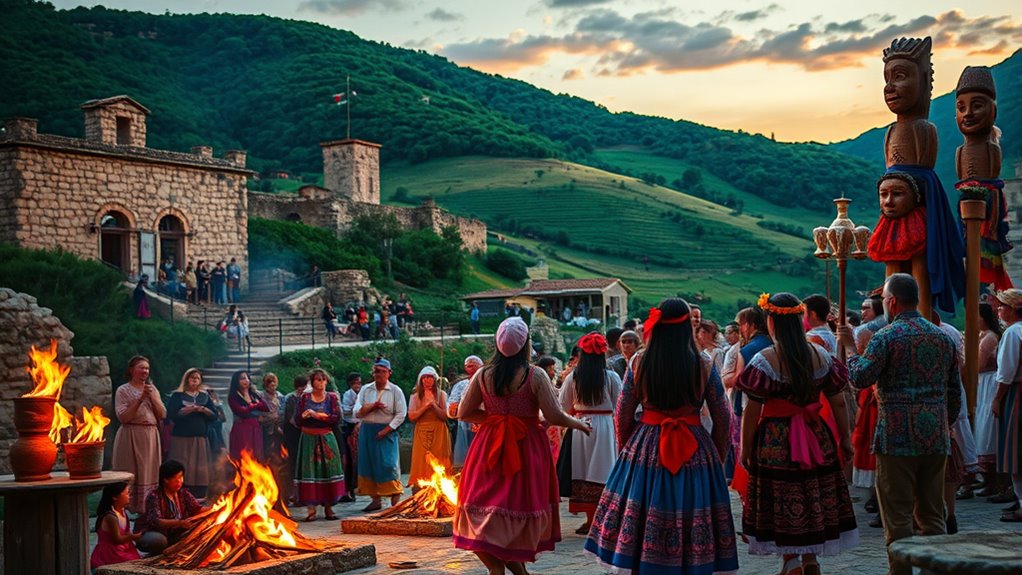
Sacred sites in Sardinia, particularly the Nuragic wells, served not only as places of worship but also as centers for incubation rituals aimed at seeking divine guidance through dreams. You might find these wells featuring architectural elements like vestibules, staircases, and hypogeic chambers, designed for ritual use. These sites were votive centers where offerings such as bronze swords, statuettes, and grains were deposited to invoke protection and fertility. During incubation, people spent time in these chambers, hoping for dreams revealing divine messages. Key features include:
- Alignment with solar events like equinox sunlight
- Use of natural water sources for purification
- Ritual deposits of votive objects and agricultural products
- Architectural design facilitating trance states
- Symbolic connection to fertility and life cycles
- Cosmic energies are believed to have been harnessed through precise astronomical alignments during certain rituals, enhancing their spiritual efficacy.
Community Bonds and Cultural Expressions Through Festivals
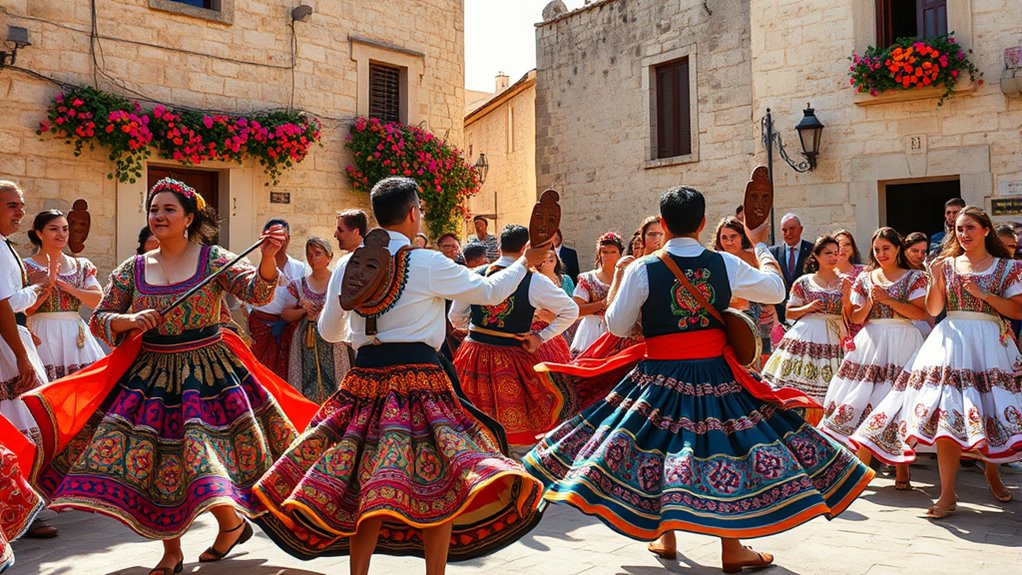
You see how rituals and symbols shape Sardinian identity during festivals, strengthening community ties through shared meaning. Traditional costumes and motifs vividly express local heritage, making cultural pride visible in every procession. These symbols and attire serve as powerful reminders of collective history and social bonds. For instance, the use of specific colors and patterns in costumes often reflects regional histories and legends, further reinforcing a sense of community identity. Additionally, the emphasis on Cultural Intelligence in understanding these symbols enhances appreciation and preservation of local traditions across generations.
Rituals Reinforcing Identity
Rituals in Sardinian festivals serve as powerful tools for reinforcing community bonds and expressing shared cultural identity. You witness this through public vows, processions, and symbolic reenactments rooted in historical events. These rituals foster a collective memory of resilience and divine protection, uniting communities across generations. During festivals like Sant’Efisio, families and villages participate in extended prayers, shared feasts, and cultural performances that strengthen social ties. The festival’s route retraces Efisio’s last days, linking Nora and Cagliari, emphasizing historical continuity. – Making vows during crises to ensure community safety – Processions honoring protectors and saints – Dancing around bonfires symbolizing renewal – Sharing traditional dishes to preserve social cohesion – Nighttime poetry and singing to pass down oral traditions. These practices intertwine history, faith, and cultural expressions, reinforcing Sardinian identity through collective remembrance and spiritual connection.
Traditional Attire and Symbols
Traditional attire and symbols play an essential role in Sardinian festivals, serving as vibrant expressions of community identity and cultural pride. You’ll notice over 400 unique costumes, each representing a specific town or social status, often showing Spanish and Moorish influences with bright colors, embroidery, and jewelry. These costumes, made from local wool (*orbace*), leather, linen, and imported silks, highlight Sardinia’s craftsmanship and trade history. Masks like Mamuthones and Issohadores symbolize opposing forces—darkness and light—embodying ancient mythologies. Ritual dressing, such as in the Sartiglia festival, elevates individuals to a divine or liminal state. Jewelry and embroidery carry symbolic meanings of wealth, protection, and regional identity, while colors like red, black, and white reflect life, duality, and purity—deeply tying attire to cultural expression. Traditional attire also often incorporates symbolic motifs and patterns that represent regional stories, beliefs, and ancestral connections, reinforcing community bonds and cultural continuity. Additionally, understanding the symbolism behind specific costume elements enhances appreciation of the cultural narratives conveyed through these traditional garments.
The Timing of Festivals in Relation to Agricultural and Seasonal Cycles
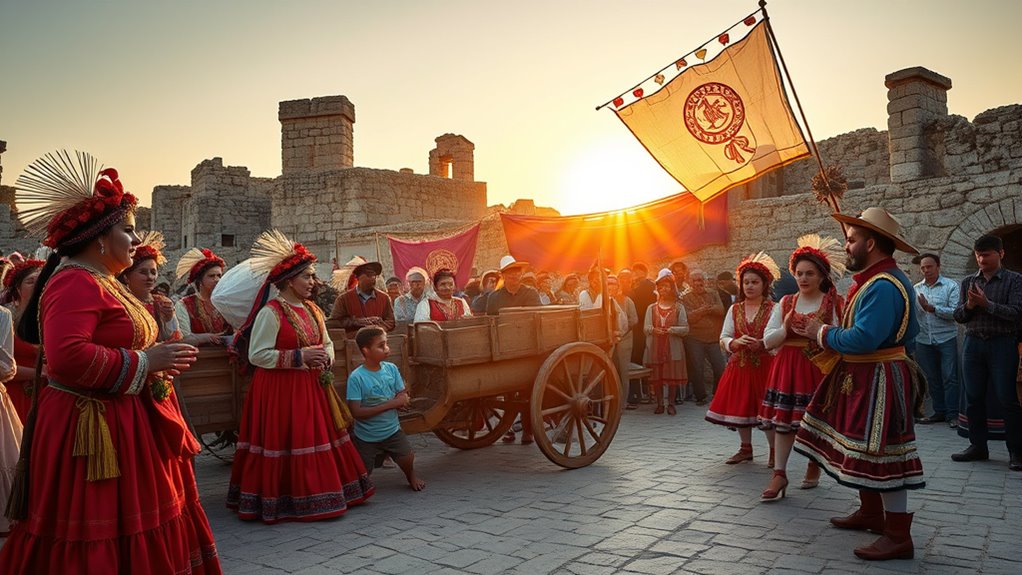
The festivals in Sardinia are carefully timed to align with key points in the island’s agricultural and seasonal cycles, ensuring that celebrations correspond to the natural rhythms of planting, growth, and harvest. You’ll notice that many events mark specific crop cycles or seasonal shifts, reinforcing the link between farming and tradition. For example:
- The Artichoke Festival in March celebrates spring planting.
- The Cherry Festival in June aligns with early summer harvest.
- August’s O Faradda marks the end of summer heat and seasonal change.
- The Mamoiada carnival in January symbolizes rebirth during winter.
- September’s barefoot race in Cabras celebrates post-harvest thanksgiving.
- These festivals often include traditional outdoor activities that reflect the seasonal timing and cultural importance of the events.
These festivals synchronize social life with farming milestones, emphasizing gratitude, renewal, and the cyclical nature of agriculture and seasons.
Symbolism and Rituals Embedded in Sardinian Celebrations
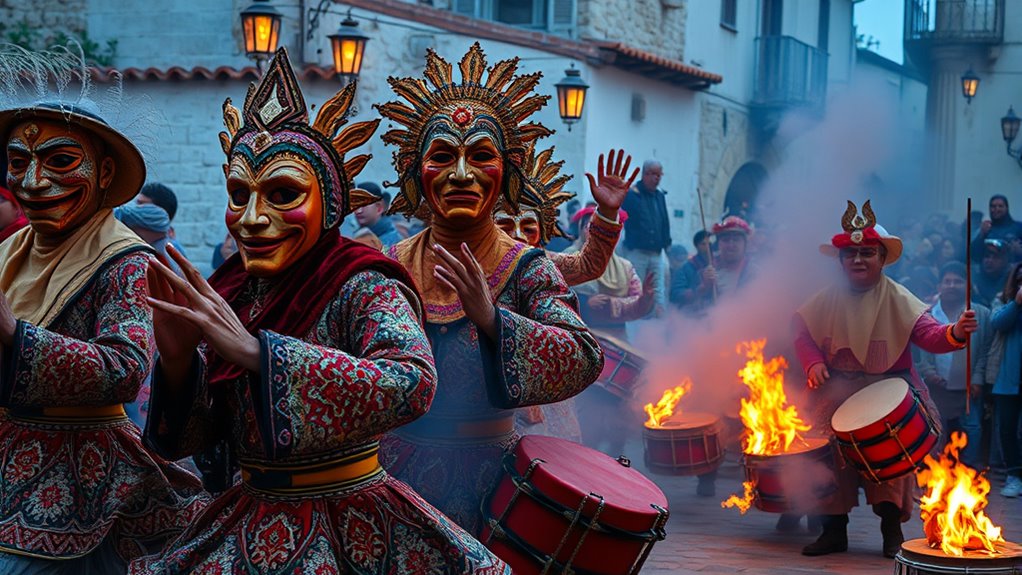
Celebrations in Sardinia are rich with symbolism and rituals that reveal deep connections to the island’s ancient past. You’ll see that Nuragic symbols of fertility and prosperity, like votive statues and sacred offerings of grains, honey, and milk, invoke abundance and divine protection. Central to these traditions was the Mother Goddess, representing life and nurturing forces essential to community survival. Sacred spaces and incubation rituals, where people sleep near tombs or sacred sites, aim to connect with ancestors and divine forces, blending spiritual and communal life. Fire rituals during San Giovanni, plant charms, and water symbolism reflect natural forces believed to protect and purify. Traditional costumes and processions serve as living symbols of cultural identity, preserving stories, history, and spiritual values through embodied acts. Additionally, ritualistic practices continue to play a vital role in maintaining the cultural heritage and spiritual identity of Sardinian communities.
The Evolution of Ancient Rituals Into Contemporary Festivities

Ancient rituals have seamlessly woven into the fabric of contemporary Sardinian festivals, allowing traditions rooted in Nuragic and prehistoric times to endure through centuries. You’ll notice practices like communal stays near sacred sites, such as novenaries around churches, echoing ancient customs of resting near sanctified spaces. Many festivals still preserve symbols of fertility and prosperity, including offerings tied to earth and water cycles. The veneration of the Mother Goddess persists in harvest and fertility celebrations, reflecting ancient spiritual beliefs. Additionally, the cyclical connection between humans and divinities remains central, seen in the sacred and communal framing of festivals. Archaeological findings have uncovered ritual objects used in ancient ceremonies, underscoring the deep historical roots of these practices. Rituals like incubation and healing practices continue, illustrating the ancient healing traditions that have persisted over millennia. Sacred spaces serve as gathering points for celebrations. Fertility symbols feature heavily in modern rites. Ancient worship of the Mother Goddess influences harvest festivals. Sacred and secular elements blend in festival structures.
Frequently Asked Questions
What Prehistoric Cultures Influenced Sardinian Festival Traditions?
You’re asking about prehistoric cultures that shaped Sardinian festival traditions. The Nuragic civilization left a strong mark with sacred sites, ritual practices, and symbolism that continue today. Additionally, prehistoric equestrian traditions influence festival displays like Sa Sartiglia, showcasing horse-riding skills rooted in ancient practices. Masked rituals like Mamuthones and Issohadores also trace back to older pagan rites, blending these ancient beliefs into modern celebrations.
How Do Sardinian Festivals Incorporate Elements From Ancient Pagan Rites?
You see that Sardinian festivals incorporate ancient pagan rites through rituals like the Mamuthones’ dance, which symbolizes seasonal renewal and fertility, and the fires of Sant’Antonio, representing purification and protection. Masks, costumes, and animal symbolism reflect spiritual beliefs predating Christianity, blending old traditions with Christian saints. By participating, you connect with centuries-old customs that reinforce community identity, ensuring these ancient rites continue to shape Sardinian culture today.
Are There Specific Symbols Unique to Sardinian Festivals?
You’ll notice that Sardinian festivals feature unique symbols like the Mamuthones’ masks and sheep fur suits, representing ancestral spirits and land. The decorated wooden candles symbolize gratitude and community, while floral carpets and offerings like honey and cereal grains honor fertility and abundance. These symbols connect deeply with regional traditions, embodying the island’s identity, spiritual beliefs, and historical roots, making each celebration rich with cultural significance.
How Have Modern Influences Changed Traditional Festival Practices?
You’ll find that about 60% of Sardinian festivals now incorporate modern elements, transforming age-old traditions. You might notice that traditional costumes use synthetic fabrics, making them more durable and affordable. Also, live streaming and social media have expanded participation beyond locals, while safety regulations sometimes alter procession routes. These changes help festivals stay relevant today, but they can also shift the community’s authentic experience and the way traditions are celebrated and preserved.
What Role Do Community Guilds Play in Festival Organization?
You see, community guilds are central to organizing festivals, taking charge of ceremonial parts like processions, rituals, and competitions. They prepare decorations, lead symbolic acts, and oversee traditions like dressing the Componidori. Guild members also raise funds, train participants, and maintain hierarchical roles that reinforce social bonds. Their involvement guarantees the festival’s cultural continuity, fostering local pride and preserving centuries-old customs for future generations.
Conclusion
By exploring Sardinia’s ancient festivals, you’ll uncover secrets lost to time, revealing rituals so powerful they’ve shaped civilizations! These celebrations aren’t just events—they’re the heartbeat of an island that holds the universe’s oldest magic. Immerse yourself, and you’ll feel the pulse of ancestors echoing through every dance, chant, and ritual. Sardinia’s festivals are a gateway to timeless mysteries, waiting to transform your understanding of history itself—prepare for an unforgettable journey into the extraordinary!



